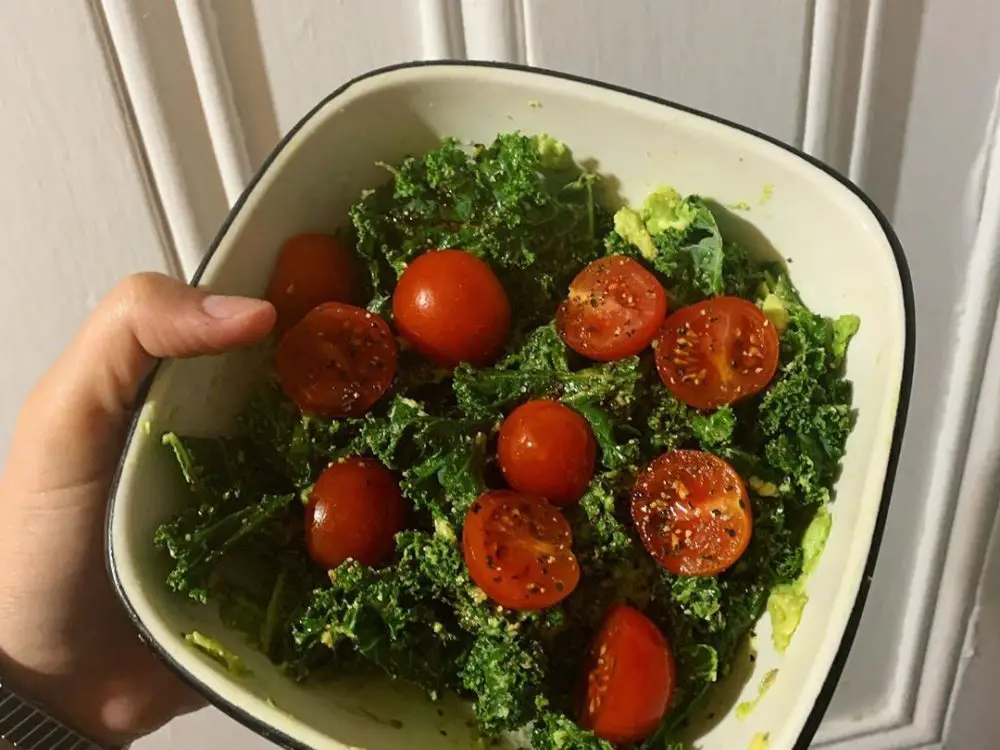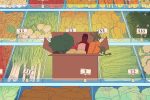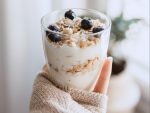Kenzie Burke has taken over the online realm of health and wellness with her promotion of the newest fad diet: food combining. Since launching her 21 Day Reset, which is available on her website for $45, several women have purchased the guide, and many have filmed their journeys on their own popular and influential YouTube channels.
This includes Maggie MacDonald and Emma MacDonald, sisters who each have greater than 100,000 views on their food combining videos.
In her YouTube video about food combining, Burke outlines her “method of transforming lives of other girls and guys.” Unfortunately, the video was deleted shortly after I studied it, but clips can be found in Abbey Sharp’s video that I discuss in detail below.
Basically, Kenzie Burke’s entire philosophy around eating revolves around the idea that different food groups take different amounts of time to digest (i.e. fruits, starches, vegetables, proteins and nuts). She describes the gut as a “one-way street” and claims that foods that digest more quickly, such as fruit, eaten after something that takes longer, such as a protein, will create something similar to a road block: “the fruit is essentially stuck on top of the chicken.”
She claims that “that alone” can cause bloating. Aside from the fruit getting “stuck” on top of the chicken, Burke offers no scientific explanation for how this phenomenon leads to bloating.
Burke then goes into how and why she follows food combining. She believes that if someone eats in a way that his or her food can be digested really quickly, the body will have more energy to do other things, such as “[regenerating] our liver, our tissue cells and help[ing] maintain our weight.”
Therefore, she believes that by saving some of this energy, food combining has helped her from feeling “sluggish” after a meal, making claims that she eats “all day long,” feels “super light and energized” all day and “[goes] to bed with a flat stomach.”
Online Criticism of Kenzie Burke and Food Combining
A huge fad diet rarely comes without criticism. Abbey Sharp, a registered dietitian, recently uploaded a YouTube video titled “Dietitian Reviews FOOD COMBINING DIET with Kenzie Burke Health for Weight Loss.” Sharp analyzes Burke and food combining using the same, recently deleted video I used to research the diet. Sharp begins with criticism of the “one-way street” analogy.
As a registered dietician, Sharp holds the knowledge that our stomach is more like a big pit full of enzymes. Nothing lies in the stomach in the order in which it was eaten. Rather, it all mixes together and is all digested at once with all the different digestive enzymes our bodies carry. Additionally, Sharp asserts that foods cannot be separated by food group, as almost all whole foods contain multiple macronutrients (fat, carbohydrates, protein).
She also debunks the idea that food being unable to digest quickly causes bloating. Instead, Sharp discusses the possibilities of bloating resulting from eating too fast, too much or from food intolerances. She also brings to light that some bloating and gas is a good thing.
In terms of Kenzie Burke herself, Sharp reveals concern over Burke’s self-description as “obsessive.” Sharp believes that this “obsessive” nature surrounding a healthy lifestyle is indicative of a possible eating disorder. Sharp also notes that at the end of Burke’s video, she promotes a program she is selling, her 21 Days to Your Best Body. Sharp has suspicions that a large portion of Burke’s extremely positive reviews of food combining are a marketing ploy.
Let’s Give It a Shot
With all this mixed information on the internet, I decided to try the diet myself. Note that I kept everything else in my life the same (sleep, activity, etc.) and only altered my diet to follow food combining rules (specifically those outlined by Kenzie Burke).
The way Burke eats in a day is as follows: lemon water first thing in the morning, followed by fruit and then a second breakfast, because fruit digests in half an hour. Following her two breakfasts, she either picks a starch or a protein and pairs it with veggies. Burke claims that following these general rules should lead to increased energy levels and decreased bloating. For more detailed information, the food combining chart I followed can be found on Burke’s blog.
Here’s how my day went.
Breakfast
Of all the parts of this diet, I dreaded breakfast the most. Breakfast is my absolute favorite meal of the day, and I generally opt for something that contains a balance of protein, carbohydrates and fats, which typically manifests as a green protein smoothie or a bowl of oats with fruit and nut butter.
However, today I could not have my favorite breakfast. Instead I followed Burke’s rule of having fruit first thing in the morning on an empty stomach with a bowl of blackberries. According to Burke’s Instagram, she often opts for avocado on toast as her second breakfast, but in order to avoid another trip to the grocery store, I had a bowl of oats with cinnamon and banana instead, since bananas are apparently an exception to the fruit first rule.
I must say, I definitely did not hate this breakfast. Everything tasted fine, but it did not hold me over. Thirty minutes after having the oatmeal, I was still starving, so I quickly had a bowl of granola with almond milk before I needed to get ready for my morning workout class. Even after having three ‘meals,’ I was left unsatisfied.
About an hour after the bowl of granola, I headed off to my local cycle studio for my regular morning spin class. On a regular morning, I would wake up and have about a liter of water and a protein smoothie to keep me hydrated and fueled for my workout.
However, this morning I was so focused on figuring out what I could and couldn’t eat, that I completely forgot to hydrate. In addition, I started to feel extremely bloated about halfway through my spin class (I’m talking serious, I-look-seven-months-pregnant bloated), and felt sluggish compared to my normal performance. I certainly did not feel the way Burke said I would.
Post Workout
Despite feeling extremely bloated and gross, I was somehow starving at the same time after my spin class. So, I had a Kenzie Burke approved smoothie recipe that I found on her Instagram story highlight under “21 BB Days” that consisted of two tablespoons of nut butter, half a banana, almond milk and vegan protein powder.
This smoothie was the closest to a “meal” I would have on a typical day and was the only thing that kept me full for more than 45 minutes. However, I still felt bloated and gross after having it, so I went on a long walk in hopes of feeling better.
Lunch
About two hours after my smoothie, I was less bloated, but still felt sluggish and lethargic. Nevertheless, I was starving (notice a trend?), so I met a friend for lunch at a local Peruvian restaurant. Since I was still feeling sort of gross, I was craving something light, such as the fruit and protein packed salad I typically order from the restaurant.
Sadly, since I had so many of Burke’s food combining rules to follow, I was not allowed to eat this salad. Instead, I ordered the only thing on the menu that was food combining friendly: rice and beans with a few pieces of carrots and onions.
I did enjoy my meal, but I couldn’t help but be envious of my friend’s beautiful, fruity salad, and the rice and beans definitely did not make me feel “light” as Burke said I should feel if I followed these foods combining rules. If how I should feel after eating really is down to the food combinations, shouldn’t I feel awesome? At this point, I am even more disappointed and am confused about why this diet seems to work for everyone but me.
Dinner
By dinner time, I was the most bloated I had been all day (and in a long time). I was tempted not to eat at all, but for the sake of properly trying this diet (and of my growing hunger pangs), I decided to roast a sweet potato (a starch) and zucchini (a ‘”neutral” vegetable) and have it over some spinach with hummus mixed in. This meal is something I have on a normal day, so I wasn’t super upset about it.
Nevertheless, I was craving something sweet at this point. Because food combining eliminates fruit from being consumed any time other than first thing in the morning, and other sugar sources are disregarded, I could not satisfy those cravings. I went to bed feeling bloated (I did not have the ‘flat stomach’ Kenzie Burke claims to have) and unsatisfied.
Final Thoughts
As someone who already has a pretty healthy diet and lifestyle, I found these food rules to be extremely restrictive. I don’t usually go through my day obsessing about food, but the day I followed this diet I did. Once it was over, I went crazy and ate everything I had craved throughout the day I was food combining, and I ate more than I normally would to the point of discomfort.
Because of my own reaction to only one day of a restrictive diet, I think this diet, or “lifestyle” as Burke calls it, could certainly be triggering for anyone with a history of disordered eating or could even drive someone into an eating disorder.
However, I don’t think Burke has bad intentions by promoting this diet. I do think it causes individuals to be more conscious of the foods they are putting into their bodies, which can lead to healthier choices. But as far as the actual food combining rules go, if I find them too limiting and I already have a healthy diet, imagine how restricting it would feel to someone who doesn’t eat as many whole foods.
So, not only are these food combining rules extremely restrictive, but they didn’t even work for me. I felt 10 times worse than I do on a normal day and even guilty and sad that such a popular and seemingly revolutionary diet didn’t work for me.
Bottom line, I don’t think this level of restriction is healthy for anyone, and I do not recommend this diet. Rather, I recommend mindfulness and balance as a road to a healthy diet.
















